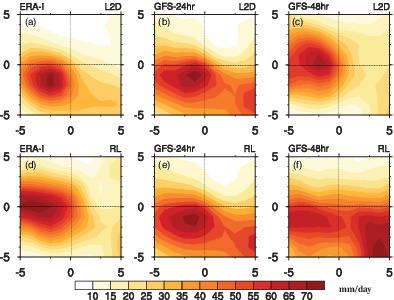当前位置:
X-MOL 学术
›
Q. J. R. Meteorol. Soc.
›
论文详情
Our official English website, www.x-mol.net, welcomes your feedback! (Note: you will need to create a separate account there.)
GFS model fidelity in capturing the transition of low-pressure area to monsoon depression
Quarterly Journal of the Royal Meteorological Society ( IF 8.9 ) Pub Date : 2021-03-23 , DOI: 10.1002/qj.4024 Sahadat Sarkar 1, 2 , P. Mukhopadhyay 1 , Somenath Dutta 3 , R. Phani Murali Krishna 1 , Radhika Kanase 1 , V S Prasad 4 , Medha S Deshpande 1
Quarterly Journal of the Royal Meteorological Society ( IF 8.9 ) Pub Date : 2021-03-23 , DOI: 10.1002/qj.4024 Sahadat Sarkar 1, 2 , P. Mukhopadhyay 1 , Somenath Dutta 3 , R. Phani Murali Krishna 1 , Radhika Kanase 1 , V S Prasad 4 , Medha S Deshpande 1
Affiliation

|
Low-pressure areas and monsoon depressions are the synoptic-scale systems that contribute largely to the Indian summer monsoon rainfall. India Meteorological Department currently uses a high-resolution (∼12 km) Global Forecasting System (GFS) model for short- and medium-range operational forecasts over the Indian region. In this study, we have evaluated the performance of the GFS model in capturing the transition of low-pressure areas (LPAs) to monsoon depressions (L2D). GFS has a good fidelity in capturing synoptic variance over the Indian region, and can simulate the composite precipitation structure for L2D cases. The upper-level warm core temperature structure is prominent for L2D cases, while it is at the lower level for the cases where the LPA does not intensify and remains as low (RL) pressure area. GFS can simulate the upper-level warm core temperature structure up to 24 hr. The model has good fidelity in capturing the upper-level potential vorticity maxima for L2D cases but amplitude is underestimated as the lead time increases. GFS fails to reproduce the potential vorticity structure and amplitude for RL cases. Positive lower- to middle-level heating to the west/southwest sector of the system is seen for L2D cases but the heating is at the lower level for RL cases. Heating structures for L2D cases are slightly underestimated by GFS but it fails to simulate the structure for RL cases. The model greatly underestimates the vertical velocity for L2D cases and RL cases with increasing lead time. Positive moisture convergence is seen at the lower level near the system centre. GFS underestimates the moisture convergence for both the cases and the southward tilt with height is also not captured well. GFS has good fidelity in simulating the dynamical parameters associated with L2D cases but shows lesser fidelity for RL cases.
中文翻译:

GFS 模型保真度捕捉低压区向季风低压区的过渡
低压区和季风洼地是对印度夏季季风降雨有很大贡献的天气尺度系统。印度气象部门目前使用高分辨率(~12 公里)全球预报系统 (GFS) 模型对印度地区进行中短期业务预报。在这项研究中,我们评估了 GFS 模型在捕捉低压区 (LPA) 向季风洼地 (L2D) 过渡方面的性能。GFS 在捕捉印度地区的天气变化方面具有良好的保真度,并且可以模拟 L2D 情况下的复合降水结构。上层暖核温度结构在 L2D 情况下较为突出,而在 LPA 未增强并保持为低 (RL) 压力区的情况下处于较低水平。GFS 可以模拟长达 24 小时的上层暖核温度结构。该模型在捕获 L2D 案例的上层潜在涡度最大值方面具有良好的保真度,但随着提前期的增加,幅度被低估了。GFS 无法重现 RL 情况下的潜在涡度结构和振幅。对于 L2D 案例,可以看到系统西/西南部分的中低层正加热,但对于 RL 案例,加热处于较低水平。GFS 稍微低估了 L2D 案例的加热结构,但未能模拟 RL 案例的结构。随着提前期的增加,该模型大大低估了 L2D 案例和 RL 案例的垂直速度。在系统中心附近的较低层可以看到正的水分收敛。GFS 低估了两种情况下的水分汇聚,也没有很好地捕捉到随着高度向南倾斜。GFS 在模拟与 L2D 案例相关的动态参数方面具有良好的保真度,但对 RL 案例的保真度较低。
更新日期:2021-03-23
中文翻译:

GFS 模型保真度捕捉低压区向季风低压区的过渡
低压区和季风洼地是对印度夏季季风降雨有很大贡献的天气尺度系统。印度气象部门目前使用高分辨率(~12 公里)全球预报系统 (GFS) 模型对印度地区进行中短期业务预报。在这项研究中,我们评估了 GFS 模型在捕捉低压区 (LPA) 向季风洼地 (L2D) 过渡方面的性能。GFS 在捕捉印度地区的天气变化方面具有良好的保真度,并且可以模拟 L2D 情况下的复合降水结构。上层暖核温度结构在 L2D 情况下较为突出,而在 LPA 未增强并保持为低 (RL) 压力区的情况下处于较低水平。GFS 可以模拟长达 24 小时的上层暖核温度结构。该模型在捕获 L2D 案例的上层潜在涡度最大值方面具有良好的保真度,但随着提前期的增加,幅度被低估了。GFS 无法重现 RL 情况下的潜在涡度结构和振幅。对于 L2D 案例,可以看到系统西/西南部分的中低层正加热,但对于 RL 案例,加热处于较低水平。GFS 稍微低估了 L2D 案例的加热结构,但未能模拟 RL 案例的结构。随着提前期的增加,该模型大大低估了 L2D 案例和 RL 案例的垂直速度。在系统中心附近的较低层可以看到正的水分收敛。GFS 低估了两种情况下的水分汇聚,也没有很好地捕捉到随着高度向南倾斜。GFS 在模拟与 L2D 案例相关的动态参数方面具有良好的保真度,但对 RL 案例的保真度较低。



























 京公网安备 11010802027423号
京公网安备 11010802027423号